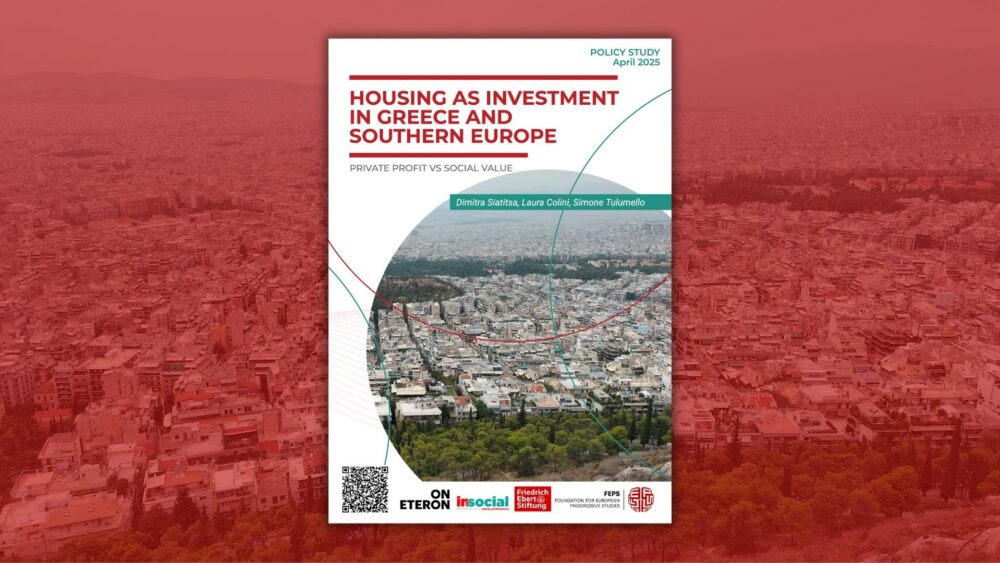
Renovating for Change: Understanding the revision process of the Buildings Directive
Background
EU elections are upon us and the European Union is preparing for the next EU term that will be the “make or break” of our 2030 climate and energy targets’ achievement. In an effort to meet these targets, the ‘Fit for 55’ Package, a landmark initiative of the current European Commission, initiated the revision process of more than a dozen of EU pieces of legislation, to ultimately translate the ambition of the European Green Deal into EU law. As part of this package, several Directives, crucial for the energy transition, such as the Energy Efficiency Directive (EED), the Renewable Energy Directive (RED), and the Energy Performance of Buildings Directive (EPBD) were revised. This process has also introduced new elements into the EU climate policy architecture, such as a new Emissions Trading System covering GHG emissions coming from the buildings and road transport (ETS2) and a Social Climate fund. 1
During the current term, we have seen more attention gradually being given to the transition of the building sector, as this accounts for 36% of GHG emissions and 40% of the total energy demand in the EU. Although, beyond the climate and energy impacts stemming from the decarbonisation of this large sector, the improvement of its energy performance is also associated with non-negligible socio-economic benefits. Amongst the latter we can recall job creation, economies of scale, lower energy bills, high indoor comfort that keep households healthy and productive. This rather “new” narrative that mixes climate and the social dimension of building renovation has been captured in an important strategy called “the Renovation Wave”. This strategy was launched by the European Commission in 2020 and proposed for the first time ever the objective to at least double the current renovation rates 2 per annum across the EU by 2030. The Strategy ultimately aims to unlock all the above mentioned multiple benefits, ensure that buildings stay on track with the EU energy and climate transition goals, while spurring on activities that can fight against ever increasing energy poverty 3 rates.
Since the COVID-19 pandemic, a stronger significance of having decent and healthy homes started gaining momentum as many of us spent significantly more time indoors. The Russian war against Ukraine has further strengthened awareness on how big of a negative impact the persistent inaction on buildings’ decarbonisation has had (and will continue to have) on EU households. All these recent shocks, together with ever decaying buildings and low climate action in the sector has trapped more and more people into uncomfortable, draughty and damp homes, left to deal with ever rising energy bills, which can put (at times severe) constraints on the purchasing power of households over goods and services. This multi-layered and challenging geopolitical context, has put the revision of the EPBD, and more broadly climate action on buildings, under a more urgent (human) perspective.
Buildings recognised as key sector of the transition: opportunities & challenges
Against this background, decarbonization of buildings has become synonymous with addressing energy security, combating poverty, and tackling climate change simultaneously. However, the challenge ahead looms large, as the urgency for change has sparked significant opposition from entrenched vested interests benefiting from the current status quo. This has turned the decarbonization of buildings into a battleground of competing private interests, employing various strategies, including fear mongering and disinformation, to hinder rapid progress.
The main point of tension in the discussions around the revision of the Energy Performance of Buildings Directive can be found in a fundamental aspect of our lives: this Directive has a direct impact on our personal living spaces. Intervening in such an intimate sphere is challenging, as it adds an unprecedented “emotional” dimension to EU policy making, which mixes itself with a limited legal mandate from the European Union. The issue around “subsidiarity” 4, in fact, has remained central to the whole EPBD revision process. This principle refers to the fact that for certain policy domains, the EU does not take action as the national, regional or local levels are best suited to deal with. As part of the latter, we can mention property law, rental law etc. Therefore, different national legislations governing the housing market and construction sector at large, coupled with competing interests stemming from the renovation ecosystem has made negotiations a challenging balancing exercise. On top of that, it’s crucial to recognise that the EPBD aims to coordinate the building decarbonization process across EU Member States, a task complicated by the diversity of homes and regional nuances.
After three turbulent years, the revised EPBD reached its final adoption in April, this year. This milestone officially commences a brand new phase for all the buildings across the EU: the implementation of the Directive. The revised text introduces important requirements to spur energy renovations. Amongst the most debated ones, we can mention the Minimum Energy Performance Standards (MEPS), a brand new “Solar mandate” and provisions to decarbonise heating and cooling in buildings. As part of the MEPS, Member States will be required to carry out the necessary renovations to achieve set energy savings targets by different dates to ultimately achieve climate neutrality by 2050 (the so-called “trajectory approach”), especially when it comes to homes. It is important to note that since its first proposal, this requirement had to go through a substantial change, as MEPS were originally intended to mandate energy renovations for all the leakiest buildings 5 across the European Union. This new element coupled with complementary requirements for adequate financing and social protection measures, while being welcomed by the environmental and social movements, raised worries coming from both the supply chain (i.e., workforce constraints and high costs of materials due to inflation), and certain actors of the housing sector, such as property owners, who raised concerns around the costs of the Renovation Wave. It is worth to note that frictions differed across national, regional and local realities hence it is difficult to create a unique and clear picture of all the interests at stake. Although without any doubt, this new provision, inserted in such a challenging historical moment, could be deemed as the spark of a “perfect storm”, which eventually led to the relaxation of the MEPS provisions in favour of more flexibility.
Firstly introduced by the REPower EU Plan 6, “The Solar Mandate” lays down requirements to ensure that certain segments of national buildings stock (mainly non-residential buildings and public buildings) are provided with solar installations (solar PVs, solar thermal panels) by certain dates, to untap the potential of Europe’s roofs to support the production of renewable energy on-site. While the Solar Mandate had been relatively easier to negotiate, the so-called “phase out of fossil fuels” provisions witnessed harsh lobbying tactics enacted by the fossil fuel industries. 7 Because of the many attacks from the gas lobby, what started as a total phase out date for all fossil fuels used in buildings by 2040, had been reduced down to a phase out date for only fossil fuel boilers 8 by 2040. As part of the law, what identifies as “fossil fuel boiler” will have to be defined in a second stage, which would leave plenty of flexibilities to secure the usage of fossil fuels for even longer than 2040 (for instance, via hybrid technologies relying partially on fossil fuels etc.).
Preparing the EPBD Implementation: complementarity is the key
All the above mentioned requirements will need to be implemented in the most ambitious and socially just way, whilst ensuring consistency (and complementarity) across the whole ‘Fit for 55 Package’ (especially with the Energy Efficiency and the Renewable Energy Directives). The implementation of the EPBD also needs to align and complement its implementation with another important piece of EU legislation, the new Emissions Trading Systems covering buildings (and road transport) GHG emissions (ETS2). The latter will require the establishment of a carbon tax on heating fuels to be borne directly by energy suppliers, and transferred onto consumers via their energy bills.
It seems clear that the EPBD, with its ultimate intent to reduce energy demand and support a phase out of fossil fuels for heating and cooling purposes, could address the likely extra costs that the new ETS2 could bring upon households, especially those living in very leaky buildings (and possibly already experiencing energy poverty). If from one hand the strong linkage between the two legislations hints at a “carrot/stick” relationship, in a context of implementation, governments will be called upon to carefully craft a comprehensive framework to spur energy renovations that responds to a threefold purpose: 1) abide with our energy and climate targets, 2) deliver comfortable and healthy homes while 3) mitigate the distributional impacts of a new carbon tax placed upon households’ heating needs.
This calls for a second important task for Member States, which is to come up with constructive approaches to prepare the population in advance for the upcoming new EU legislation taking shape at national level. As the EPBD experienced such a harsh backlash during its revision process, the likelihood that campaigns against climate action on buildings may arise again during its implementation phase remains high. Especially in view of a possible extra complication coming from the effects stemming from the implementation of the ETS2, all Member States will need to ensure that buildings’ legislation truly leaves no one behind.
The establishment and implementation of the Social Climate Fund (which earmarks a portion of the ETS2 revenues to mitigate possible negative social impacts of its implementation) could help this purpose, but in view of its rather limited financial envelope 9, innovative ways to ensure that financial support is adequate and most importantly accessible to a wider range of households (and prioritised amongst those in vulnerable situations) will be of crucial importance. A delicate though much needed balance between ambitious climate action and social protection measures will need to be nailed if the European Union is truly serious about carrying out a just transition towards climate neutrality, with the buildings sector at the forefront of this change.
Negotiations: a delicate balance between capitals and EU level
All the points of frictions presented above are inherently linked to numerous vehement oppositions, employing aggressive strategies such as media attacks or political campaigns fueled by fear mongering, disinformation, and anti-climate narratives at national level. But how did we transition from the proud announcement of the ambitious Fit for 55 Package to a fast spreading (far-right-led) dissent for the Green Deal? 10
As mentioned earlier, the current legislative environment has developed amidst a series of ongoing and interconnected crises, leading to a bleak outlook characterised by a resurgence of poverty in many EU countries and the looming threat of war. Consequently, this elicited a sense of fear and discontent towards Institutions. This environment has gradually intensified, with various far-right parties and media outlets orchestrating a grand narrative against climate action. This narrative portrayed ambitious climate policies mandated by the EU as an imposition on citizens’ way of life, pointing out that ambitious climate policy would entail unbearable costs on citizens. This narrative has steadily gained momentum throughout the legislative process, reaching a climax during the recent farmer protests in cities across Europe. When discussing the Greek case, it’s impossible to overlook the still ongoing impact of the 2008 financial crisis, which plunged Greek society into a state of apprehension regarding any potential economic shocks which could still create a conducive environment for this narrative to thrive.
Throughout the EPBD negotiations, numerous assaults stemming from far-right platforms could be witnessed, as these found fertile ground in a challenging historical moment characterised by a cost of living and a housing crisis that called for an ever stronger link between climate and social policies. For instance, in the lead-up to the plenary vote (starting from the end of January 2023) on the EPBD, right-wing parties in Italy launched a significant attack opposing the Directive, which was taken up by a large number of media outlets 11. During the negotiations on a heating law in Germany the following summer, a campaign depicting a cultural war emerged in response to the proposed heating law, polluting the discussions on the EPBD. 12
Beyond Italy and Germany, which have been the major examples of how the media can alter the making of EU buildings policies, even countries that have stayed rather neutral in the public discourse have advanced worries towards more ambitious policies. In Greece, for instance, if from one end a strong focus has been placed on the unsuitability of Greek homes in front of increasing cases of heat waves (which highlights the importance of energy efficiency and its popularity in the country), on the other, more recent criticisms placed in mainstream media highlighting the high costs 13 that homeowners will have to bear, have started to surface.
Towards the end of the revision process, which runs in parallel with the end of the European Parliament’s current legislature, and in response to the worries rising from the capitals, we could see for instance a reconfiguration of political alliances, with the centre-right EPP discreetly seeking potential allies among far-right political families of ID and ECR 14. From the side of the Council of the EU, an interesting, yet worrying trend saw no Member State wanting to really become a champion for ambition when it came to the negotiations on the final text of the EPBD. Amongst the most vocal Member States (i.e. France, Germany, Italy, Spain etc.), there has always been a high level of fragmentation in positions when it came to different requirements and provisions stemming from the Directive. This created different impasses, which eventually led to a very flexible final legislative text.
Even though few to no Member State took the lead in championing ambition, cross-countries alliances formed along the way. For instance, as far as “MEPS” were concerned, the new “trajectory approach” design mentioned above for the residential sector, rapidly gained momentum in the Council because it was the only way to ensure a certain level of flexibility to Member States. Another topic that saw a clear split and subsequently, more favour towards less ambition, was the introduction of the fossil-fuel boilers phase out date by 2040. The change was broadly supported by the majority of Member States, from the West to East of Europe and concentrated especially in Central Eastern Europe and Southern Europe.
Even though the constellation of different positions makes it difficult to create any consistent trends, the majority of Member States consistently positioned themselves to lower the level of ambition in favour of flexibility, especially for these two above-mentioned requirements. Even though considered pretty neutral, Greece has been taking part in the trend. Beyond its heavy dependence on oil and coal, which explains the country’s choice to secure a role for gas boilers as transitional technologies throughout the sector’s decarbonisation pathway; opting for more flexible MEPS could be linked to a series of macroeconomic factors that mix with the strategic priorities of a country whose priority is to maintain economic stability. As one of the different sectors where Greece has found a lever to deliver economic prosperity, tourism can be mentioned. The possibility of frontloading efforts in creating new infrastructures and avoiding any limitation to the hospitality sector, could have been a factor that might have played (and could still play) a role towards the country’s willingness to implement any stringent requirements that would have given a massive push to renovation activities (which would require financing, time and space). Moreover, prioritisation of strategic sectors for the Greek economy ultimately steers the country’s ultimate investment decisions. This reflection is particularly important if we look at how public money will be channelled in future national budget laws. Ensuring that there is an adequate and inclusive enabling framework for renovations, which prioritises the use of public resources to support the most in need, is a foundational factor that can dictate the success of buildings policies at national level, not only in view of the achievement of our climate and energy goals but also to gain consensus within the public opinion. Building on the experience of the “Eksoikonomo” scheme, a programme to be deemed successful in the eyes of the public needs to be continuous, not administratively burdensome and it should prioritise the most in need (especially when public money is used).
In light of the above and in a context of implementation, as there will be a natural inclination of Member States to opt for a rather soft transposition of the legal text (due to its high level flexibility), it will be of utmost importance to leverage the multi-layered nature of renovation activities and invest in all the enabling factors that could support them in an equitable manner. An ambitious, socially inclusive implementation of the EPBD can ensure that upgrading our buildings delivers economic prosperity, improves lives for households and supports our fight against climate change.
Conclusions & next steps
The forthcoming implementation phase holds significant importance in facilitating a just transition toward a decarbonized and healthy built environment in the EU. Once the EPBD is ratified, Member States will have 24 months to transpose it into national law and fulfil various requirements, including the submission of a draft National Building Renovation Plan (NBRP) by the end of 2025. These plans will specify the different policies and measures Member States will carry out in order to reach the targets set in the EPBD (and beyond). Given the particularities across Member States, and in view of the flexibilities provided in the Directive, inaction on buildings cannot be an option. Member States should rather build upon the granted flexibilities and come up with innovative ways that will support them in going beyond what’s enshrined in the EPBD.
For instance, establishing enabling frameworks that facilitate adequate and targeted financial and technical support, all the while ensuring strong social safeguards, could be a way to ensure the EPBD will trigger the needed energy renovations and achieve our climate and energy target in a socially just way. Furthermore, it’s crucial that the technical policy efforts undertaken at the EU level are accurately comprehended and implemented at the national level. As CAN Europe, which is a network of over 200 Members organisations spread out across the European Union, we are committed to accompany and positively influence national governments in making the right decisions when it comes to translating the EPBD into national law.
Within this framework, the Build Better Lives (BBL) campaign, which is a joint initiative by CAN Europe and Friends of the Earth Europe, aims to ensure that the Directive delivers on its promise of affordable, healthier, and climate-resilient households for all. A campaign joined by almost 90 social justice, housing, climate, and youth civil society organisations has united to advocate for the fulfilment of this promise, emphasising the necessity of addressing housing in all its complexity. Moving forward, it is essential for the campaign to ensure that at a national level that the EPBD effectively addresses housing challenges with an ambitious implementation. As demonstrated by Eteron’s recent project ‘Mind the Roof,’ substantial energy upgrades are imperative in the housing sector. Yet it is as important to integrate these upgrades into a comprehensive housing strategy that addresses the entirety of housing needs in all their complexity in Greece. The stakes are high, but the potential benefits of a successful implementation of the EPBD brings the promise of building better lives. Let’s make sure we don’t miss this opportunity.
Renovating for Change
8MB
- This new Fund aims at earmarking a portion of the revenues from the ETS2 to ultimately support vulnerable/low-income households and energy poor in the energy transition towards more energy efficient and decarbonised buildings (and road transports[↩]
- The aggregated annual renovation rate across Member States in the EU stays around 1% each year. See here[↩]
- At least 9,3% of the EU population, representing approximately 42 million people across the EU, are unable to keep their home warm, which is a dimension of energy poverty[↩]
- https://eur-lex.europa.eu/EN/legal-content/glossary/principle-of-subsidiarity.html#:~:text=Specifically%2C%20it%20is%20the%20principle,national%2C%20regional%20or%20local%20level[↩]
- Buildings with an Energy Performance Certificates of G or F needed to reach a level “E” by 2030/2033[↩]
- In response to the hardships and global energy market disruption caused by Russia’s invasion of Ukraine, the Commission launched the REPowerEU Plan that aims at saving energy, producing clean energy and diversifying energy supplies. As part of the latter requirements to untap solar energy production of roofs were introduced in the legal text of the EPBD[↩]
- For example the case of the Liquid Gas Industry reported by DeSmog[↩]
- To date, no EU definition for “fossil fuel boilers” exists, although [↩]
- SCF should mobilise at least €86.7 billion over the 2026-2032 [↩]
- https://www.euractiv.com/section/politics/news/some-rn-meps-sign-resolution-to-abolish-green-deal/[↩]
- https://www.euractiv.com/section/energy-environment/news/italian-politics-threatens-to-torpedo-eu-buildings-directive/[↩]
- https://www.politico.eu/article/robert-lambrou-alternative-for-germany-heat-pump-election-climate-change/[↩]
- https://www.protothema.gr/economy/article/1350242/neoi-belades-gia-akinita-me-hamili-energeiaki-klasi/[↩]
- https://www.energymonitor.ai/policy/green-deals/eu-green-deal-in-peril-as-parliament-faces-shift-to-the-right-elections/?cf-view[↩]




